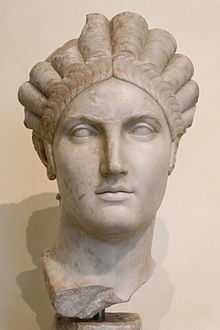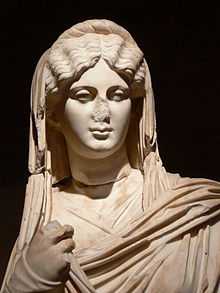Roman hairstyles

Hairstyle fashion in Rome was ever changing, and particularly in the Roman Imperial Period there were a number of different ways to style hair. Much the same with clothes, there were several hairstyles that were limited to certain people in ancient society. Styles are so distinctive they allow scholars today to create a chronology of Roman portraiture and art; we are able to date pictures of the empresses on coins, or identify busts depending on their hairstyles.
Significance
Much like today, hair for the Romans was as much an expression of personal identity as clothes. Hairstyles were determined by a number of factors, namely gender, age, social status, wealth and profession. How one dressed one's hair was an indication of who you were and what your role in society was.
Hair was a very erotic area of the female body for the Romans, and attractiveness of a woman was tied to the presentation of her hair. As a result, it was seen as appropriate for a woman to spend time on her hair in order to create a flattering appearance. Lengthy grooming sessions for women were tolerated, despite writers such as Tertullian and Pliny commenting on their abhorrence for time and energy women dedicate to their hair.[1] However, the numerous depictions of women hairdressing and mirror-gazing in tomb reliefs and portraiture is a testament to how much hairdressing was seen as part of the female domain.[2]
In more than just attractiveness though, hairstyling was the leisure pursuit of the cultured, elegant female. Hair was seen as much as an indication of wealth and social status as it was of taste and fashion. But unlike modern-day hairstyles, comfort and naturalism for the Romans took a back-seat to hairstyles that displayed the wearer's wealth to a maximum. In other words, having a complex and unnatural hairstyle would be preferred to a simple one, because it would illustrate the wealth of the wearer in being able to afford to take the time to do their hair.[3]
A 'natural' style was associated with barbarians, who the Romans believed had neither the money nor the culture to create these styles. Incidentally, the association with barbarians was why Roman men kept their hair cut short.[3] It was the job of slave hairdressers, called Ornatrices, to create their master's hairstyle new each day, and so too of pulling out any grey hairs.[4]
Apart from society, hair was used symbolically to mark rites of passage; for instance loosened hair was common at a funeral, and the seni crines was the hairstyle worn by brides and Vestal Virgins; divided and plaited into six braids, and in the case of the bride, it was parted with a spear.[5]
Headgear

Veils
Perhaps due to its erotic association, hair was often linked with Roman ideas of female modesty and honour. We know that veils were important in this case, as they protected (or encouraged according to Seneca the Elder) against solicitations by men.[6] The Palla was the mark of a married, respectable woman. It was a piece of cloth wrapped around the body with one end over the shoulder. There is significant evidence for the palla being draped over the back of the head as a veil.[7]
The palla supposedly signified the dignity and sexual modesty of a married woman, but due to its encumbering nature as a veil, there has been much debate whether it was only worn in public by the aristocracy, or if at all by working women of lower classes.[8] Vittae were woollen fillets that bound a married woman's hair. They were another indication of a wife's modesty and purity and were seen as part of the clothing and presentation of a matron.[9] Vittae could be inset with precious stones, or in the case of the Flaminicae, they would be purple in colour.
Wigs
Due to the nature of hair and the relatively wet climate in the upper reaches of the Empire, there are very few examples of wigs that survive to this day. We do know that women wore wigs whether they were bald or not. So too did men, Emperor Otho wore a wig, as did Domitian.[10] Wigs allowed women to better achieve the kind of 'tall' styles that particularly punctuated the Flavian and Trajanic eras (e.g. the periods of 69-96 and 98-117 CE). In fact, so tall were these hairstyles, that ancient writer Juvenal likens them to multi-storey buildings.
So important is the business of beautification; so numerous are the tiers and storeys piled one upon another on her head!
Wigs were made from human hair; blonde hair from Germany and black from India were particularly prized, especially if the hair came from the head of a person from a conquered civilisation.[12] In the cases where wigs were used to hide baldness, a natural look was preferred supposedly using a wig with a hair colour similar to the user's original. But in instances where a wig was worn for the purpose of showing off, naturalism did not play much of a part. In fact, obviously fake wigs were preferred, sometimes intertwined with two contrasting hair colours.[13]
A main advantage of wigs for the Romans is that they could be directly pinned onto the head of the wearer, meaning that a style could be achieved a lot faster than if it had been done with the sitter's own hair. Further it would lessen the inconvenience of having to grow one's own hair too long. It has been suggested that the necessary length to be able to create these hairstyles daily would be well below the shoulder, perhaps to the waist.[14]
There were two types of wig in Roman times, the full wig, called the capillamentum, and the half wig, called the galerus.[15] The galerus could be in the form of a fillet of woolen hair used as padding to build an elaborate style, or as a toupee on the back or front of the head. Toupees were attached by pins, or by sewing the toupee onto a piece of leather and attaching it as a wig. Further, glue could be used to affix it to the scalp or alternatively, as a bust from the British Museum illustrates, the toupee could be braided into the existing hair.[16]
Janet Stephens is an amateur archaeologist and hairdresser who has reconstructed some of the hairstyles of ancient Rome, attempting to prove that they were not done with wigs, as commonly believed, but with the person's own hair.[17]
Detachable marble wigs
Busts themselves could have detachable wigs. There have been many suggestions as to why some busts have been created with detachable wigs and some without. Perhaps the main reason was to keep the bust looking up-to-date. It would have been too expensive to commission a new bust every time hair fashion changed, so a mix-and-match bust would have been preferable for women with less money.[18] Perhaps another reason was to accommodate the Syrian ritual of anointing the skull of the bust with oil.[18]
Or further, in cases where the bust was a funerary commission, it can be safely assumed that the subject of the bust would not have had an opportunity to sit for another portrait after their death.[19] Hence why a detachable wig for a bust would certainly be useful. Although exactly how these marble wigs were attached is unknown, the likely difficulty of changing the 'wigs' effectively would have probably put many women off choosing a detachable and reattachable bust in the first place.[20]
Tools of the trade
Dyes
Dying hair was popular among women, although the frequency that hair was coloured often made it weaker. Tertullian discusses how hair dye burnt the scalp and was harmful for the head.[21] Artificial dyes could be applied through powders, gels and bleach. Henna, a temporary dye, or even animal fat, could be applied to make the hair more manageable.[22] Aside from henna, more common permanent dyes were based on natural substances and perhaps more unorthodox mixtures. For example, to dye hair black, Pliny the Elder suggests applying leeches that have rotted in red wine for 40 days.[23]
Dying hair red requires a mixture of animal fat and beechwood ashes[24] whilst dying hair gold required Saffron.[25] Ovid gives plenty more examples for dyes, such as herbs and saffron.[26] Interestingly, to cure diseases such as hair loss, Pliny suggests the application of a sow's gall bladder, mixed with bulls urine, or of the ashes of an ass's genitals, or other mixtures such as the ashes of a deer's antlers mixed with wine. Further, goat's milk or goat's dung is said to cure head lice.[27]

Curling irons, pins and hairnets
The calamistrum was the name for the Roman curling iron. It consisted of a hollow metal outer cylinder and a smaller solid cylinder inside it. The hair would be wrapped around the solid cylinder and inserted into the metal outer. The metal outer would be heated in a fire, making the hair curly. It has been reported that because of the frequency and temperature that hair was curled at, thinning and damaged hair was common amongst women[28]
While gel and henna, as mentioned above, were used to manage hair, hairnets and pins were in common usage too. Poorer women would have used wooden pins, while the aristocracy used gold, ivory, crystal, silver or painted bone. The pins would have been decorated with carvings of the gods, or beads and pendants.[29]
Styles over time
Roman hairstyles changed, but there were several constant hairstyles that were used continuously, such as the tutulus, or the bun. The beehive, helmet, hairbouquet or pillbox are modern day names given to Roman hairstyles.
The Tutulus
The tutulus, originally an Etruscan style, was a hairstyle worn primarily by the materfamilias, the mother of the family.[30] It was a hairstyle that remained in constant use even when fashion changed. To achieve it, the hair was divided and piled high and shaped into a bun. After which it was tied with purple fillets of wool. By the end, the hair would be conical in shape. It was also the hairstyle worn by the flaminicae.[30]

Republican Period and Augustan era styles
The Republican Period and the nodus style was particularly common. The nodus style saw the hair parted in three, with the hair from the sides of the head tied in a bun at the back while the middle section is looped back on itself, creating an effect not unlike the (comparably modern) Pompadour style.[31] Livia, wife of Augustus, and Octavia, sister of Augustus, particularly favoured the nodus style, both continuing to use it well into the Imperial Period.[32]
Other styles in the Julio-Claudian era were designed to be simple, with hair parted in two and tied in a bun at the back. This was perhaps done in order to juxtapose Roman modesty against Cleopatra and her flamboyance.[33]
Flavian and Antonine hairstyles
Flavian and Antonine hairstyles are perhaps the most famous, and extravagant, of Imperial Rome's styles. The styles were lofty, deeply drilled with curls and braids. The high arching crowns on the front were made using fillets of wool and toupees, and could be attached to the back of the head as well as the front. Typically, as in the case of the famous Fonseca Bust (pictured), the hair was combed into two parts; the front section was combed forwards and built with curls, while the back was plaited and coiled into an elaborate bun.[34]
The later Antonine Period saw curls at the front of the head brought to a lower level than the Flavian Period. The braids coiled at the back of the head are brought further forward, instead often resting on the top of the head. Another style of the Antonine period saw the hair separated into rivets and tied at the back[35]
Severan dynasty
Julia Domna, wife of Septimius Severus, had a particularly notable hairstyle. She wore a heavy, globular wig with simple finger-sized waves with a simple center parting. Julia Domna was from Syria, and it has been suggested that her style was indicative of her foreign origins.[36] Despite being from the East, she adopted a wig to project a familiar Roman guise and particularly in order to imitate her predecessor, Faustina the Younger.[37] In 2012 Janet Stephens's video Julia Domna: Forensic Hairdressing, a recreation of a later hairstyle of the Roman empress, was presented at the Archaeological Institute of America’s annual meeting in Philadelphia.
Foreign women often wore their hair differently from Roman women, and women from Palmyra typically wore their hair waved in a simple center-parting, accompanied by diadems and turbans according to local customs. Women from the East were not known to commonly wear wigs, preferring to create elaborate hairstyles from their own hair instead.[37] As time progressed, Severan hairstyles switched from the finger-waved center parting style, to one with more curls and ringlets at the front and back of the head, often accompanied by a wig.[38]
See also
- Janet Stephens
- Greco-Roman hairstyle
- Clothing in ancient Greece
- Clothing in ancient Rome
- Women in Ancient Rome
- Stola
References
- ↑ Tertullian., De Culti Feminarum,2:7
- ↑ Kampman (1981), 149–52
- ↑ 3.0 3.1 Bartman (2001), 6
- ↑ Carcopino (1973), 167
- ↑ Bartman (2001), 4
- ↑ Seneca the Elder., Controversiae 2.7.6
- ↑ Olson (2008), 33
- ↑ Fantham (2008), 166-7; Olsen (2008), 33-6 both offer discussion on this
- ↑ Olson (2008), 36
- ↑ Suetonius., Life of Otho, 12 ; Morgan (1997), 214
- ↑ Juvenal., Satire Book 6, 58-9
- ↑ Ovid, Amores, 1:14:45-6 ; Bartman (2001), 14
- ↑ Bartman (2001), 14
- ↑ Olson (2008), 71; Bartman (2001), 10
- ↑ Olson (2008), 74
- ↑ Bust of Matidia, London, The British Museum 1805.7- 3.96; Bartman (2001), 10
- ↑ Pesta, Abigail (2013-02-06). "On Pins and Needles: Stylist Turns Ancient Hairdo Debate on Its Head". Wall Street Journal. Retrieved 2014-01-22.
- ↑ 18.0 18.1 Kleiner and Matheson (1996), 174
- ↑ Fittschen and Zanker (1983), 105
- ↑ Bartman (2001), 19
- ↑ Tertullian, De Culti Feminarum, 2:6
- ↑ Bartman (2001), 12 Hair and the Artifice of Roman Female Adornmentdoi:10.2307/507324; Allason-Jones (1989), 133-7
- ↑ Pliny the Elder., Natural History, 32:23
- ↑ Pliny the Elder., Natural History, 28:51
- ↑ Tertullian, De Culti Feminarum, 2:6:1
- ↑ Ovid., Ars Amatoria, 3:158-64
- ↑ Pliny the Elder., Natural History, 28:46
- ↑ Olson (2008), 73
- ↑ Kleiner and Matheson (1996), 162; Olson (2008), 75-6
- ↑ 30.0 30.1 Olson (2008), 39
- ↑ Examples of the Nodus style
- ↑ Further examples of the Nodus and
- ↑ Kleiner and Matheson (1996), 37
- ↑ Bartman (2001), 18
- ↑ Examples of the Antonine styles and riveted
- ↑ Bartman (2001), 17
- ↑ 37.0 37.1 Bartman (2001), 17-8
- ↑ Example of Severan style, finger waves underneath Palla
External links
| ||||||||||||||||||||||||||||||||||||||||||||||||||||||||||||||||||||||||||||||